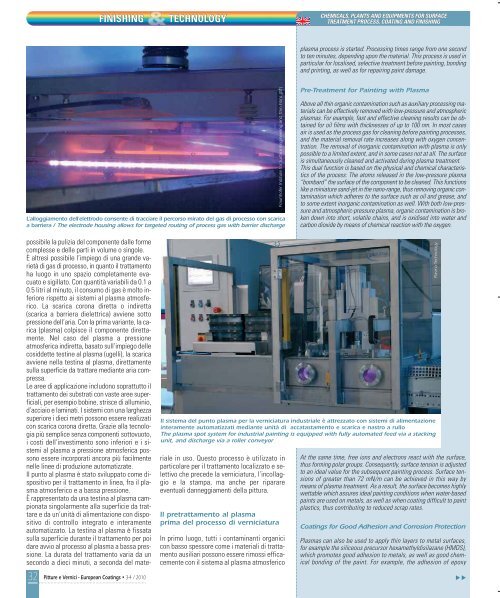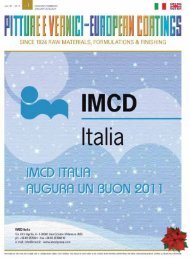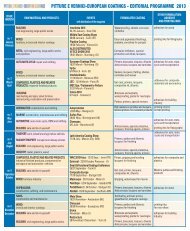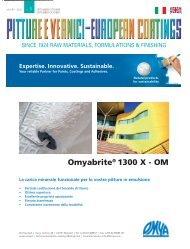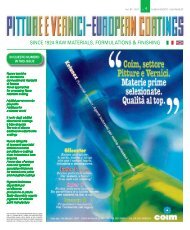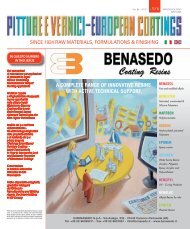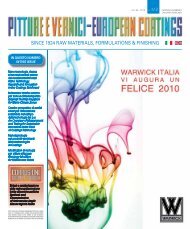Create successful ePaper yourself
Turn your PDF publications into a flip-book with our unique Google optimized e-Paper software.
possibile la pulizia del componente dalle forme<br />
complesse e delle parti in volume o singole.<br />
È altresì possibile l’impiego di una grande varietà<br />
di gas di processo, in quanto il trattamento<br />
ha luogo in uno spazio completamente evacuato<br />
e sigillato. Con quantità variabili da 0.1 a<br />
0.5 litri al minuto, il consumo di gas è molto inferiore<br />
rispetto ai sistemi al plasma atmosferico.<br />
La scarica corona diretta o indiretta<br />
(scarica a barriera dielettrica) avviene sotto<br />
pressione dell’aria. Con la prima variante, la carica<br />
(plasma) colpisce il componente direttamente.<br />
Nel caso del plasma a pressione<br />
atmosferica indiretta, basato sull’impiego delle<br />
cosiddette testine al plasma (ugelli), la scarica<br />
avviene nella testina al plasma, direttamente<br />
sulla superficie da trattare mediante aria compressa.<br />
Le aree di applicazione includono soprattutto il<br />
trattamento dei substrati con vaste aree superficiali,<br />
per esempio bobine, strisce di alluminio,<br />
d’acciaio e laminati. I sistemi con una larghezza<br />
superiore i dieci metri possono essere realizzati<br />
con scarica corona diretta. Grazie alla tecnologia<br />
più semplice senza componenti sottovuoto,<br />
i costi dell’investimento sono inferiori e i sistemi<br />
al plasma a pressione atmosferica possono<br />
essere incorporati ancora più facilmente<br />
nelle linee di produzione automatizzate.<br />
Il punto al plasma è stato sviluppato come dispositivo<br />
per il trattamento in linea, fra il plasma<br />
atmosferico e a bassa pressione.<br />
È rappresentato da una testina al plasma campionata<br />
singolarmente alla superficie da trattare<br />
e da un’unità di alimentazione con dispositivo<br />
di controllo integrato e interamente<br />
automatizzato. La testina al plasma è fissata<br />
sulla superficie durante il trattamento per poi<br />
dare avvio al processo al plasma a bassa pressione.<br />
La durata del trattamento varia da un<br />
secondo a dieci minuti, a seconda del mate-<br />
32<br />
Pitture e Vernici - European Coatings • 3-4 / <strong>2010</strong><br />
FINISHING TECHNOLOGY<br />
L’alloggiamento dell’elettrodo consente di tracciare il percorso mirato del gas di processo con scarica<br />
a barriera / The electrode housing allows for targeted routing of process gas with barrier discharge<br />
riale in uso. Questo processo è utilizzato in<br />
particolare per il trattamento localizzato e selettivo<br />
che precede la verniciatura, l’incollaggio<br />
e la stampa, ma anche per riparare<br />
eventuali danneggiamenti della pittura.<br />
Il pretrattamento al plasma<br />
prima del processo di verniciatura<br />
In primo luogo, tutti i contaminanti organici<br />
con basso spessore come i materiali di trattamento<br />
ausiliari possono essere rimossi efficacemente<br />
con il sistema al plasma atmosferico<br />
Fraunhofer Institute for Surface Engineering and Thin Films (IST)<br />
CHEMICALS, CHEMICALS, PLANTS PLANTS AND AND EQUIPMENTS EQUIPMENTS FOR FOR SURFACE SURFACE<br />
TREATMENT TREATMENT PROCESS, PROCESS, COATING COATING AND AND FINISHING FINISHING<br />
plasma process is started. Processing times range from one second<br />
to ten minutes, depending upon the material. This process is used in<br />
particular for localised, selective treatment before painting, bonding<br />
and printing, as well as for repairing paint damage.<br />
Pre-Treatment for Painting with Plasma<br />
Above all thin organic contamination such as auxiliary processing materials<br />
can be effectively removed with low-pressure and atmospheric<br />
plasmas. For example, fast and effective cleaning results can be obtained<br />
for oil films with thicknesses of up to 100 nm. In most cases<br />
air is used as the process gas for cleaning before painting processes,<br />
and the material removal rate increases along with oxygen concentration.<br />
The removal of inorganic contamination with plasma is only<br />
possible to a limited extent, and in some cases not at all. The surface<br />
is simultaneously cleaned and activated during plasma treatment.<br />
This dual function is based on the physical and chemical characteristics<br />
of the process: The atoms released in the low-pressure plasma<br />
“bombard” the surface of the component to be cleaned. This functions<br />
like a miniature sand-jet in the nano-range, thus removing organic contamination<br />
which adheres to the surface such as oil and grease, and<br />
to some extent inorganic contamination as well. With both low-pressure<br />
and atmospheric-pressure plasma, organic contamination is broken<br />
down into short, volatile chains, and is oxidised into water and<br />
carbon dioxide by means of chemical reaction with the oxygen.<br />
Il sistema del punto plasma per la verniciatura industriale è attrezzato con sistemi di alimentazione<br />
interamente automatizzati mediante unità di ac catastamento e scarica e nastro a rullo<br />
The plasma spot system for industrial painting is equipped with fully automated feed via a stacking<br />
unit, and discharge via a roller conveyor<br />
At the same time, free ions and electrons react with the surface,<br />
thus forming polar groups. Consequently, surface tension is adjusted<br />
to an ideal value for the subsequent painting process. Surface tensions<br />
of greater than 72 mN/m can be achieved in this way by<br />
means of plasma treatment. As a result, the surface becomes highly<br />
wettable which assures ideal painting conditions when water-based<br />
paints are used on metals, as well as when coating difficult to paint<br />
plastics, thus contributing to reduced scrap rates.<br />
Coatings for Good Adhesion and Corrosion Protection<br />
Plasmas can also be used to apply thin layers to metal surfaces,<br />
for example the siliceous precursor hexamethyldisilazane (HMDS),<br />
which promotes good adhesion to metals, as well as good chemical<br />
bonding of the paint. For example, the adhesion of epoxy<br />
Plasma Technology<br />
▼<br />
▼


